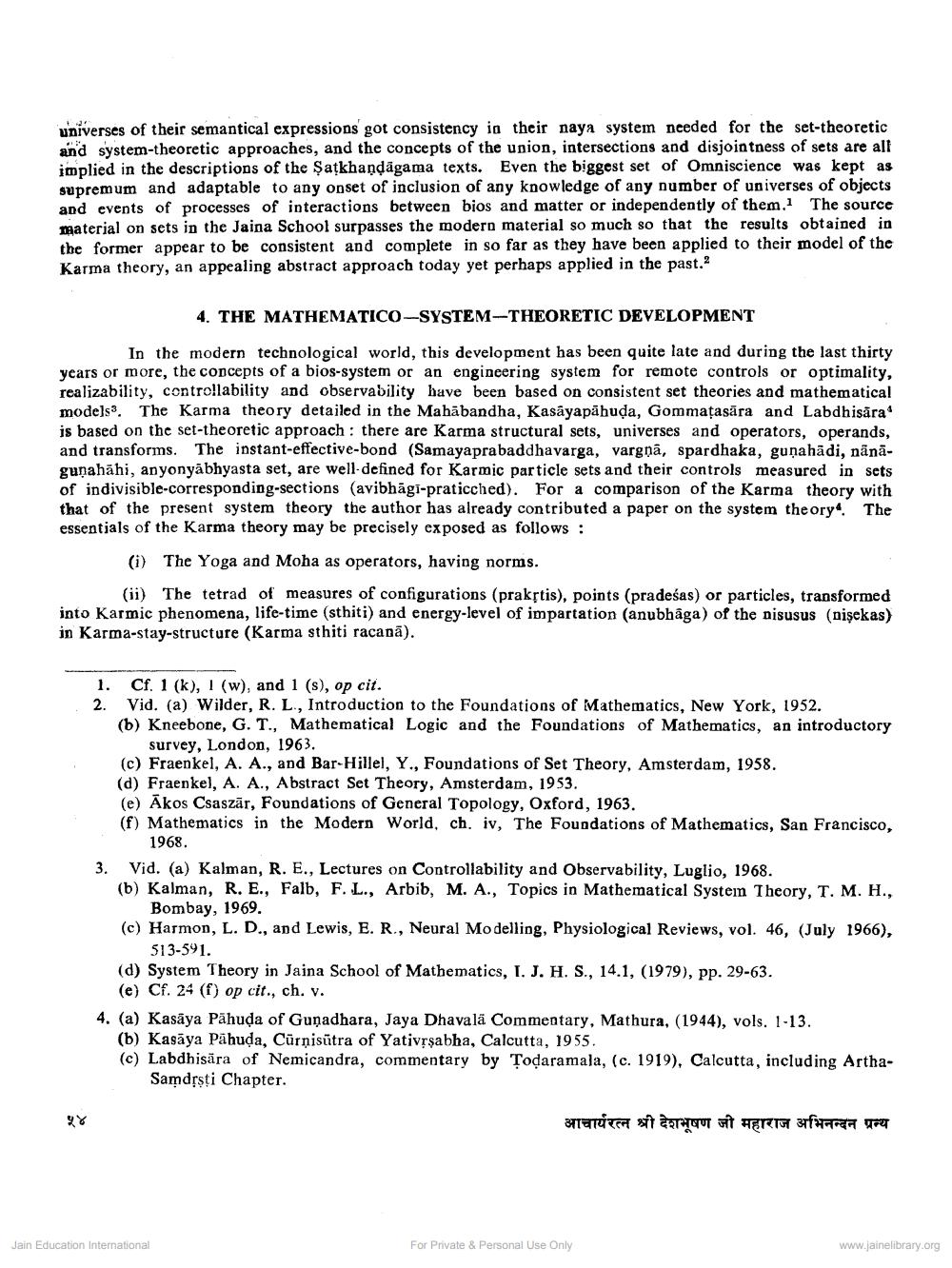Book Title: Jaina Ulterior Motive of Mathematical Philosophy Author(s): L C Jain, C K Jain Publisher: Z_Deshbhushanji_Maharaj_Abhinandan_Granth_012045.pdf View full book textPage 6
________________ universes of their semantical expressions got consistency in their naya system needed for the set-theoretic and system-theoretic approaches, and the concepts of the union, intersections and disjointness of sets are all implied in the descriptions of the Satkhandagama texts. Even the biggest set of Omniscience was kept as supremum and adaptable to any onset of inclusion of any knowledge of any number of universes of objects and events of processes of interactions between bios and matter or independently of them. The source material on sets in the Jaina School surpasses the modern material so much so that the results obtained in the former appear to be consistent and complete in so far as they have been applied to their model of the Karma theory, an appealing abstract approach today yet perhaps applied in the past.? 4. THE MATHEMATICO-SYSTEM-THEORETIC DEVELOPMENT In the modern technological world, this development has been quite late and during the last thirty years or more, the concepts of a bios-system or an engineering system for remote controls or optimality, realizability, controllability and observability have been based on consistent set theories and mathematical models. The Karma theory detailed in the Mahābandha, Kasayapāhuda, Gommațasāra and Labdhisăra is based on the set-theoretic approach : there are Karma structural sets, universes and operators, operands, and transforms. The instant-effective-bond (Samayaprabaddhavarga, vargņā, spardhaka, gunahādi, nanagunahāhi, anyonyabhyasta set, are well-defined for Karmic particle sets and their controls measured in sets of indivisible-corresponding-sections (avibhāgi-praticched). For a comparison of the Karma theory with that of the present system theory the author has already contributed a paper on the system theory The essentials of the Karma theory may be precisely exposed as follows: (i) The Yoga and Moha as operators, having norms. (ii) The tetrad of measures of configurations (prakstis), points (pradeśas) or particles, transformed into Karmic phenomena, life-time (sthiti) and energy-level of impartation (anubhåga) of the nisusus (nişekas) in Karma-stay-structure (Karma sthiti racanã). 1. Cf. 1 (k), 1 (w), and 1 (s), op cit. 2. Vid. (a) Wilder, R. L., Introduction to the Foundations of Mathematics, New York, 1952. (b) Kneebone, G. T., Mathematical Logic and the Foundations of Mathematics, an introductory survey, London, 1963. (c) Fraenkel, A. A., and Bar-Hillel, Y., Foundations of Set Theory, Amsterdam, 1958. (d) Fraenkel, A. A., Abstract Set Theory, Amsterdam, 1953. (e) Ākos Csaszār, Foundations of General Topology, Oxford, 1963. (f) Mathematics in the Modern World, ch. iv, The Foundations of Mathematics, San Francisco, 1968. 3. Vid. (a) Kalman, R. E., Lectures on Controllability and Observability, Luglio, 1968. (b) Kalman, R. E., Falb, F.L., Arbib, M. A., Topics in Mathematical Systein Theory, T. M. H., Bombay, 1969. (c) Harmon, L.D., and Lewis, E. R., Neural Modelling, Physiological Reviews, vol. 46, (July 1966), 513-591. (d) System Theory in Jaina School of Mathematics, I. J. H. S., 14.1, (1979), pp. 29-63. (e) Cf. 24 (f) op cit., ch. V. 4. (a) Kasāya Pähuda of Guņadhara, Jaya Dhavala Commentary, Mathura, (1944), vols. 1-13. (b) Kasāya Pāhuda, Cürņisūtra of Yativrsabha, Calcutta, 1955. (c) Labdhisära of Nemicandra, commentary by Todaramala, (c. 1919), Calcutta, including Artha Samdssti Chapter. आचार्यरत्न श्री देशभूषण जी महाराज अभिनन्दन ग्रन्थ Jain Education International For Private & Personal Use Only www.jainelibrary.orgPage Navigation
1 ... 4 5 6 7 8 9 10 11
